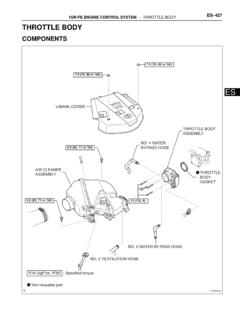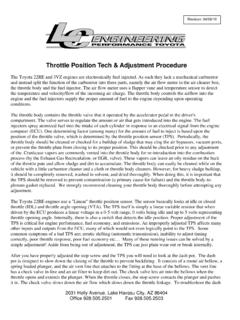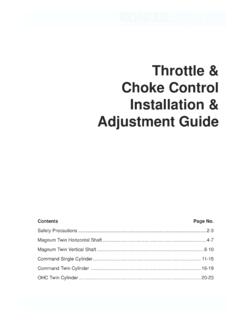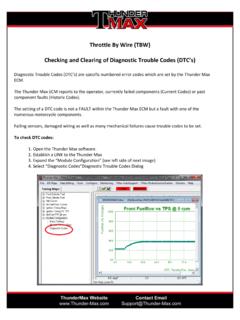Transcription of Co2 Throttle Stop (#TS and #TSP) - Drag Racing …
1 Co2 Throttle Stop (#TS and #TSP) **Keep in mind that this cylinder takes the place of a portion of your linkage. It becomes part of your linkage and should free floating . It does not get a solid mounting. INSTALLATION: 1) Mount the Throttle stop linkage stud in the upper hole of the carburetor linkage. 2) Connect the airline to the port in the bottom of the solenoid. (If you purchased a needle valve, connect the air line to it. Close the needle valve all the way and open it four turns.) This is done by taking the 1/4 inch diameter nylon tubing airline and pushing it into the needle valve fitting until it bottoms out. No tools are required. To disconnect the air line, push in the ring on the fitting and simply pull the tubing out. 3) The gold t/s solenoid has a port labeled "EXH". This stands for exhaust and it must either be left open.
2 4) Turn on the CO2 bottle and set the pressure regulator at 75-85 Psi. The stop should retract and go to its shortest position. Test the operation of the cylinder at both full and closed Throttle to be sure there is no interference. 5) If your car uses a 1/4 diameter rod linkage, select the stop bolt with the 1/4-28 thread. If your car uses a Throttle cable, select the bolt with the 10-32 thread. Thread the jam nut onto the stop bolt and then thread the bolt into the back of the Throttle stop until it contacts the piston inside the stop. Lock down the jam nut. 6) Have a friend step on the gas pedal to full Throttle . Open the carburetor linkage by hand to full Throttle . Allowing for 3/8 inch of thread engagement into the stop bolt, mark the Throttle linkage rod for cutting or measure how far back the cable mounting point must be moved (depending on the type of Throttle linkage used).
3 After cutting, Re-threading or moving the cable mount, screw everything back together and check for full Throttle position. Final adjustment can be made by screwing the rod/cable into or out of the stop bolt or by adjusting the Throttle stop rod end at the carburetor linkage. Make sure that the stop is in the retracted position (shortest length) during all of the above steps. OPERATION: 1) When CO2 is applied to the inlet of the solenoid, the stop will close to its shortest length thereby allowing the carburetor to go to full Throttle when you step on the gas.
4 When power is applied to the solenoid, the stop expands to its longest length. The Throttle spring causes the expansion, so use a good return spring. Make sure that the spring pulls with less than 40 pounds at full Throttle . This can be checked with a fishing scale. 2) The adjustment bolt in the rear of the stop will adjust the amount that the Throttle closes when 12 volts is applied to the solenoid. Refer to our helpful tips to find a good Throttle closing for your application. 3) The adjustment bolt will not change the overall length of the stop. Turning the adjustment bolt counterclockwise will lengthen the stroke of the stop- thereby causing your Throttle to shut down more when 12 volts is applied to it. (Turning the adjustment bolt clockwise will shorten the stroke- causing your Throttle stop to shut down less when 12 volts is applied.
5 WIRING: This Throttle Control can either be used as a downtrack Throttle stop or a starting line rpm control. As a downtrack Throttle stop: -The solenoid has 2 wires. Connect one wire to a GOOD chassis ground. Connect the other wire to the Throttle stop timer. Refer to the timer for proper wiring (it usually goes to the terminal labeled either Off/on, Throttle Stop, or ) As a starting line control: (using the Throttle control in place of a 2-step) -The solenoid has 2 wires. Connect one wire to a GOOD chassis ground. Connect the other wire to your hot transbrake solenoid wire. **When using this Throttle control with one of our Mega Series Delay boxes, simply connect the solenoid wire to the delay box terminal labeled either Throttle Stop or SFO.
6 The second solenoid wire goes to ground. (Refer to your delay box instructions). Maintenance- It is a good idea to lubricate this system once a year. To do this, turn off the CO2 bottle valve and disconnect the air line that goes from the bottle into the fitting on the solenoid. Place 2 or 3 drops of a light oil into the solenoid fitting. Air tool oil is good, do not use a solvent based oil. Biondo Racing Products, Inc., shall not be liable for injury, consequential, or other type of damages resulting from the use of it s products. This warranty is in lieu of all other warranties of merchantability or fitness of use. Tips on Using a Throttle Stop Written by Peter Biondo Through years of on track experience with Throttle stop Racing I have learned a few things about Throttle stops that can serve as a guideline to help in your Throttle stop Racing . 1/ FINDING THE RIGHT Throttle STOP "CLOSED POSITION" OR "BLADE ANGLE" - Finding how much to mechanically shut your Throttle down is crucial.
7 You want to find a setting that will work well and be consistent. I have found 3 blade angles that work well (find the settings below). The most accurate way to adjust your "blade angle" is by RPM- (the rpm your engine drops to while the Throttle stop is engaged). Once you have the right Throttle stop RPM, you are done with the mechanical part of it, and all ET adjustments should be done with a timer. As mentioned above, I have found 3 blade angles that work well: - A " Throttle stop rpm" of 3900- this will work well if your car runs 1 second under the index. - A " Throttle stop rpm" of 4300- this will work well if your car runs .3 to .9 under the index. - A " Throttle stop rpm" of 4800- this will work well if your car runs less than .3 under the index. ** If shifting on time, please refer to that section below as the suggested t/s rpm is different. 2/ FIGURING OUT YOUR Throttle STOP RATIO - Before figuring out your ratio you first must enter a number in timer 1 of your Throttle stop timer.
8 This number indicates when the Throttle stop will come on after launch. Most people prefer to have this number set early for high mph. I recommend having the Throttle stop come on between .1 and .3. Once you set this, you will never adjust it again. To adjust your ET you will change timer 2. Whether you are using a weather station to predict a Throttle stop or not, I highly recommend you learning your Throttle stop ratio. The Throttle Stop Ratio is the effect the Throttle stop time has on your ET. Here's an example- if you add 2 tenths (.2) to your Throttle stop timer and it changes your ET by 1 tenth (.1), then you have a 2 to 1 ratio. To learn your ratio do the following: Make one run with a small amount of time (duration) in the Throttle stop timer (.5). Make a second run with a large amount of time ( ). Let's say run # 1 was an and run # 2 was an You can figure out your Throttle stop ratio by dividing the change in the Throttle stop time by the change in ET.
9 The change in Throttle stop time divided by the Change in = T/S Ratio. OR ( divided by = 2). This is called a 2 to 1 ratio. Learning your ratio will allow you to correct for changing track and air conditions. Your ratio depends on your " Throttle stop rpm". For most applications a 3900 T/S rpm results in a 2 to 1 ratio, a 4300 T/S rpm results in a 3 to 1 ratio, and a 4800 T/S rpm results in a 5 to 1 ratio. These ratios are based on cars equipped with converters that stall in the 5600-6400 area. Extremely loose or tight converters will result in different ratios. 3/ YOUR Throttle LINKAGE - An "In-linkage" Throttle control is sensitive to the entire Throttle linkage system. It is very important to have an absolutely solid and rigid pedal stop. Without this you can stretch your linkage causing inconsistency. Your cable attaching bracket must also be rigid.
10 Any flexing or binding will ruin the consistency. 4/ TIME SHIFTING WHILE ON THE STOP Is it beneficial to shift on time (have a timer shift the car during the stop duration) while on the stop? The answer really depends on how fast your car runs. Example: If your car runs well under the index (over 1 second under the index), you can gain consistency by shifting on a time. There are 2 major benefits for shifting on time. The car will come off the stop in high gear, lessening the chances of spinning the tires at that point. The rpm s on the stop will be much more stable when in high gear. In other words, your stop rpm s will climb at a much slower rate when in high gear compared to low gear. This will result in more consistency and a more predictable Throttle stop ratio. ** Cars running less than 1 second under the index will most likely not benefit from shifting by time.










